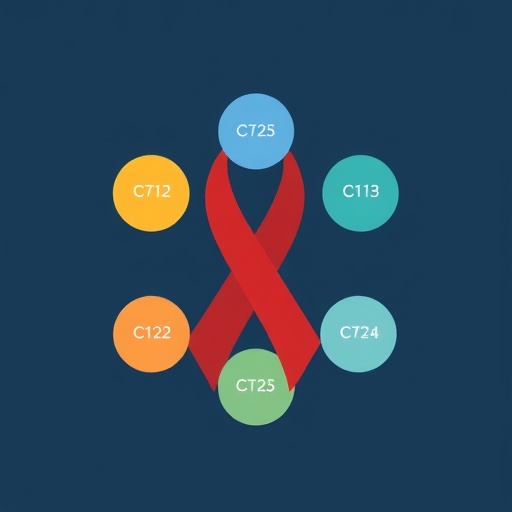Although classical Hodgkin’s lymphoma is generally easily treatable today, many aspects of the disease still remain a mystery. A team at the Max Delbrück Center led by Professor Claus Scheidereit has now identified an important signaling molecule in the biology of this lymphoma: LTA. It helps the cancer to grow unimpeded – for example, by activating genes for immune checkpoint ligands that protect tumor cells from the body’s built-in defense system.
Hodgkin’s lymphoma is a cancer that develops in the lymphatic system and is accompanied by swelling of the lymph nodes and other symptoms such as fever, night sweats, and weight loss. It is characterized by the presence of so-called Hodgkin’s cells and large multinucleated Reed-Sternberg cells. An unusual feature of this form of lymphoma is that only a small proportion of the tumor mass is made up of malignant cells. The swelling of the lymph nodes is more due to the fact that Hodgkin’s cells send out signaling molecules that attract lymphocytes and allow them to migrate into the lymph nodes.
Today, recovery rates for patients with Hodgkin’s lymphoma are good: More than 90 percent of patients with localized Hodgkin’s lymphoma and more than 80 percent of patients with advanced Hodgkin’s lymphoma can be cured. “Given, however, that the disease affects many young people with a long life ahead of them after completing treatment, chemotherapy – the standard form of treatment for the disease – can prove to be problematic,” says Professor Claus Scheidereit, head of the research group on Signal Transduction in Tumor Cells at the MDC. Chemotherapy can cause lasting damage to healthy tissue, leading to late effects including heart and lung disease, hormonal disturbances, infertility, and secondary tumors. “We therefore need to develop new therapeutic approaches that help prevent such problems,” says Scheidereit.
NF-kB permanently located in the nucleus of the cancer cells
The researcher and his team are working closely with the research group of Professor Stephan Mathas of the MDC and Charité – Universitätsmedizin Berlin, as well as with other MDC research groups, to closely investigate the mechanisms that contribute to the development of Hodgkin’s lymphoma. “We have known for a long time that NF-kB plays a central role in the disease,” says Scheidereit. This is a transcription factor that boosts the activity of certain genes. It is usually located in the cell’s cytoplasm, and only temporarily migrates into the nucleus when required. Here, it controls gene expression and returns to the cytoplasm once its work is done. In Hodgkin’s cells, however, NF-kB is permanently located in the cell nucleus and influences gene activity in such a way that, instead of undergoing programmed cell death, the cells proliferate unchecked and release signaling molecules that lure lymphocytes into the diseased lymph nodes. “Until now, however, we have only partially understood why NF-kB remains in the nuclei of Hodgkin’s cells,” explains the MDC researcher.
In order to better understand this mechanism, the team of scientists conducted tests on cell cultures to see which of the molecules produced by Hodgkin’s cells activate NF-kB. The results of their tests were published in the scientific journal Blood. “We identified one single factor that is secreted by Hodgkin’s cells and activates NF-kB: a signaling molecule called lymphotoxin-alpha, or LTA for short,” says Dr. Eva Kärgel, a research assistant in Scheidereit’s team who co-authored the study. An analysis of data from lymph node tissue samples confirmed that Hodgkin’s lymph nodes produce a significant amount of LTA. “We were also able to show that, vice versa, inhibiting LTA blocked the NF-kB activity in Hodgkin’s cells,” says Kärgel.
A target for new treatment strategies?
With the help of gene expression analyses, Scheidereit’s team of scientists was able to prove that LTA plays a central role in Hodgkin’s cells: Not only does it activate NF-kB, but it also triggers the release of various signaling molecules that contribute to the migration of lymphocytes into the lymph nodes and create a favorable microenvironment for the cancer cells. It also ensures that the cancer cells express so-called immune checkpoint ligands, which protect them from attacks by the immune system.
There is a reason that LTA is so active in Hodgkin’s cells: “We have discovered that LTA upregulates itself through a positive feedback loop,” explains Scheidereit. A regulator called A20 can put the brakes on this loop. But it is often mutated in Hodgkin’s lymphoma, which causes it to lose its function as a control mechanism.
With LTA, MDC scientists have identified an important player in the disease progression of Hodgkin’s lymphoma, as Scheidereit emphasizes: “Our work suggests that LTA could be a good target for diversifying the existing treatment strategies for Hodgkin’s lymphoma.”
###
Original publication
Linda von Hoff et al. (2019): “Autocrine LTA signaling drives NF-κB and JAK-STAT activity and myeloid gene expression in Hodgkin lymphoma.” Blood. DOI: 10.1182/blood-2018-08-871293
The Max Delbrück Center for Molecular Medicine
The Max Delbrück Center for Molecular Medicine in the Helmholtz Association (MDC) was founded in Berlin in 1992. It is named for the German-American physicist Max Delbrück, who was awarded the 1969 Nobel Prize in Physiology and Medicine. The MDC’s mission is to study molecular mechanisms in order to understand the origins of disease and thus be able to diagnose, prevent, and fight it better and more effectively. In these efforts the MDC cooperates with Charité – Universitätsmedizin Berlin and the Berlin Institute of Health (BIH) as well as with national partners such as the German Center for Cardiovascular Research (DZHK) and numerous international research institutions. More than 1,600 staff and guests from nearly 60 countries work at the MDC, just under 1,300 of them in scientific research. The MDC is funded by the German Federal Ministry of Education and Research (90 percent) and the State of Berlin (10 percent), and is a member of the Helmholtz Association of German Research Centers.
http://www.
Media Contact
Jana Schluetter
[email protected]
Related Journal Article
https:/
http://dx.




